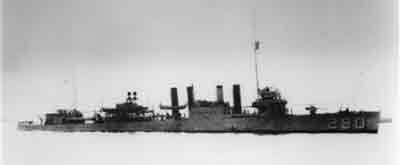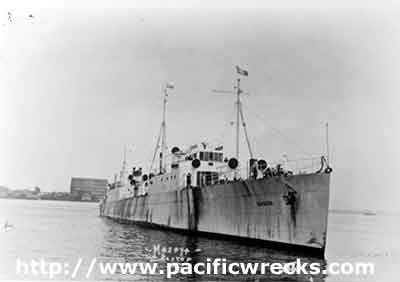|
|
|
| Missing In Action (MIA) | Prisoners Of War (POW) | Unexploded Ordnance (UXO) |
| Chronology | Locations | Aircraft | Ships | Submit Info | How You Can Help | Donate |
|
| U.S. Army Cargo Formerly USN Clemson-class destroyer Standard Fruit Company Cargo 1,174 Tons (Masaya) 314' 5" x 31 8" x 9' 3" (As Masay 1942-1943 1 x 40mm Bofors 20mm cannons .50 cal machine guns  USN c1942  USN c1942  Don Fetterly 1994 |
Ship History Built by the Fore River Shipbuilding Corporation, Quincy, MA. Laid down July 28. 1919 as a Clemson-class destroyer as one of four funnel flush deck destroyers. Launched February 19, 1919 as USS Dale (DD-290) named for Richard Dale. Comissioned February 16, 1920 in the U.S. Navy (USN) with Commander F. H. Roberts in command. During the late 1920s, operated with Destroyer Squadrons, Scouting Fleet off the east coast of the United States and in the Caribbean Sea and Panama Canal. On September 21, 1929 arrived Philadelphia and was prepared for decommissioning with the removal of the engine, wartime equipment, armament, shaft, propellers and struts. On May 1, 1930 decommissioned. Afterwards, sold to Standard Fruit Company and renamed MV Masaya and converted into a commercial cargo ship at New Orleans with a new power plant installed for use as a cargo ship. Afterwards, manned by a crew of nineteen, operated between between New Orleans and Central America where her shallow draft enabled her to go up rivers to plantations thus eliminating rail transportation. The ship could carry roughly 25,000 stems of fruit and at 16 knots used fans to circulate air to eliminate the need for refrigeration. Wartime History In early 1942, General MacArthur requested ships for use as blockade runners to steam from the United States to Corregidor. The three banana boats including Masaya were bareboat charter by U.S. Army and equipped with anti-aircraft armament manned by U.S. Army personnel for use as cargo vessels. Loaded and loaded with military cargo of ammunition, aviation gas, medical supplies and mail. On March 3, 1942 loaded with cargo including ammunition, aviation gas, medical supplies and mail departs New Orleans via Panama Canal then via Los Angeles and Honolulu where it would cross the Pacific bound for Corregidor. While at Honolulu, the ship was informed the Philippines surrendered and instead diverted to Australia. Diverted to Australia, operated by an Australian captain and crew of nineteen sailors with U.S. Army gun crews. Afterwards, used as a transport in Australia and New Guinea. On March 24, 1943 at 9:16am departs Milne Bay transporting personnel and cargo bound to Tufi Harbor where she embarks additional cargo. On March 28, 1943 departs Tufi Harbor bound for Oro Bay where additional personnel including 50 soldiers that would serve as a local defense force for the new PT Boat Base planned at Douglas Harbor. Also aboard was cargo including 500 fuel drums, portable radios, spare parts, general cargo and personnel. Sinking History On March 28, 1943 Masaya was roughly six miles off Oro Bay. Meanwhile, a Japanese formation of eighteen D3A Vals escorted by forty fighters were inbound to strike Oro Bay. Spotting Masaya, five Vals broke off from the formation and made a dive bombing and strafing attack. They released six bombs and scored three direct hits on the stern and sank stern first at 1:13pm. When the supplies were not delivered, the development of Douglas Harbor was delayed a month and Morobe River PT Boat Base (Morobe PT Boat Base) developed instead. Shipwreck The shipwreck of Masaya rest on her starboard side at a depth of 165'. Visibility can be from poor to 60 feet. Her stern has extensive bomb damage as well as damage from hitting the bottom. Over the past 50 or so years the sea has done major damage to her thin plates but there is still plenty to see. Damage caused by the bombing and impact with the seabed are clearly visible just forward of the stern. The hull is buckled, the stern deck area and associated internal works are smashed. The deck with the houses attached has broken free of the hull, has slid down several feet towards the starboard side, and now rests on the sand. The deck is detached from the stern to a point forward of no 1 hatch where it remains attached to the hull detachment of the deck has opened up the internal spaces of the ship and should make penetration much easier and safer. Don Fetterly recalls: "The exact position of Masaya is restricted because of the cargo she was carrying and the pristine nature of the wreck, we want to keep it that way. There is another reason due to the depth 175' it is not a dive that should be undertaken by most divers. The wreck is unstable and has many places where a diver can get trapped. On the second dive of the wreck in 1996 we nearly lost a diver who did not follow instructions. He became trapped inside the wreck with a silt out and escaped by removing all his gear a squeezing between the roof beams. In the process he lost his new Sony video camera and housing which has not been found. He then had to perform a blue water staged decompression while low on air as he could not locate the assent line." References Although designated MV Masaya some sources list as SS Masaya. At Close Quarters PT Boats in the United States Navy (1962) page 184 U.S. Army Small Ships Association Inc. - Vernon Kite Thanks to Don Fettery for additional information Contribute
Information Last Updated
|
1943 Configuration 165' - 175' Shipwreck Photo Archive Saga of the SS Masaya by Don Fetterly |
| Discussion Forum | Daily Updates | Reviews | Museums | Interviews & Oral Histories |
|